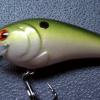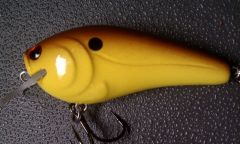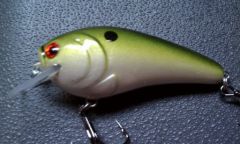-
Posts
17 -
Joined
-
Last visited
Profile Information
-
Location
Rome, GA
-
Interests
Wooden fishing lures including crankbaits, topwaters, and jerkbaits.
buffingtonwa's Achievements
Newbie (1/14)
1
Reputation
-
Bob - I don't know anything about chemical compositions so I can't really speak on what causes the above listed problems, but when one of my friends was using my baits, he had issues with the devcon breaking free of the lexan and lips pulling out. Once that happened, I went back and did tests. In addition to the lip breaking free from the bait (this is a brittle factor that most other topcoats don't have since their shore harness isn't as high as the D2T, which is 83/84 vs 80 on most of the other known finishes), I found that the D2T makes the lip more susceptible to breakage. It doesn't crack or snap, but tends to tear like it's been weakened. If you've ever dipped lexan in propionate and then twisted it, it's something like that, it's definitely like something in the D2T is breaking down/weakening the lexan. Honestly, unless you really tried to do this, it's not something most people might notice or even attribute to the epoxy, but when I had these problems and investigated more thoroughly, that's what I found. Also, to combat the lip from breaking free, we've since started drilling holes in the back end of our lips so there is a more mechanical bonding than there was before. Bluetick - there are 2 different products from flexcoat that we use. One is epoxy, that we use for its adhesive properties, i.e. to glue baits together/lexan lips into place. The other is Flexcoat Ultra V rod finish, which we use as a lure finish. I know there are extensive threads on this site about different finishes, and we chose this one for it's hardness/flexible properties, as well as the UV stable claim the company makes. I've used the ACC (and E-tex) as well, though I didn't put that in above thread. They are both good finishes. The only problem I have with those is the well known "multi-coat" requirement, otherwise, they are both good products that I've not found any real problems with, so far.
-
Like many of you on this site, I was a devout fan of Devcon 2-Ton (D2T) epoxy for numerous processes of lure making. I used it for gluing in lexan lips, gluing the 2 sides of my lures together (I make CNC milled 2-part crankbaits), and sealing/finishing. However, this year, I discovered that the chemical composition of D2T actually makes lexan bittle and prone to breaking at the point it goes into the bait, as well as becoming brittle itself once and being easily cracked after a week or so after curing (the brittleness of D2T can actually make the lips crack free of the lipslot and be easily pullled out). The cracking can also make paint chip away from the surface of wooden baits more easily...and other nasty things can happen. After discovering this, my partner and I began a long (about 5 month) testing period with other chemicals. We tried all sorts of epoxies and polyurethanes from eagerplastics.com, flexcoat products, CA products, marine adhesives, moisture cured urethanes, polyurethanes, etc (probably over $1000 in diff chemicals). The only ones we did not test that I know of were UV cured. What we found was that for gluing parts, including lexan to wood, the flexcoat epoxy (not finish) works best for us. There is no lip breakage from chemical interaction at all with this product and it doesn't become brittle like D2T. For a finish, we've decided on the flexcoat UV rod finish works best. It is a bit tough to mix without getting bubbles, but the end results are hard, durable, and provide a bit of flex for when those errant casts send your bait into a pile of rip rap (or if you're clumsy like me, you bang the lure on your trolling motor while casting). We seal with propionate .For those of you who do detailed baits, like we do, propionate helps to keep the detail of the bait until you are ready to paint (unlike 2-part seals which smooth everything out), and then a thick coat of Flexcoat UV encapsulated the detail and creates a really cool effect on the bait. Anyway, I hope this helps all you lure makers, expert and novice alike! Full disclosure: I have no affilitation with Flexcoat or any of their products other than being a converted customer!
-

Sealing And Finishing Detailed Balsa Crankbaits
buffingtonwa replied to buffingtonwa's topic in Hard Baits
After lots and lots of experimentation, I've settled on propionate. For me, it seals great, keeps the detail fairly well and gives me the best hardness I can expect when making a balsa lure with detail. I do have to sand a little bit between dips to keep the detail sharp, but overall I like the results. I found superglue to be troublesome for a couple of different reasons, and lacquer sanding sealer didn't quite give me the hardness I was looking for (though it is great for preserving the detail and filling grain). I still use the sanding sealer to make the grain pop, then I sand it down really smooth and seal with propionate dips; for me it's usually 4 dips. I've also tried a bunch of different finishes (D2T, Flexcoat, ACC, ETex, and DN, to name a few) I haven't found any that I'm totally satisfied with yet, and I may end up compromising on one of those listed, but one thing I have found is that for a raised detail bait, the 2-parts finishes do something the urethanes do not, and that's encapsulate/smooth the detail. I really like that the detail can still be seen through the finish, but is smoothed out to the touch. It makes a nice effect when the bait is completed. Anyway, thanks for all the suggestions. I think I tried most of them and this is what I finally decided works best for me (at least for the moment) -
-
-
The company specified a 100:90 ratio by weight in the paperwork sent with the epoxy, so that's the way I did it (typo above). I would agree that the epoxy needs to be mixed more, except that the stuff in the mixing cup all cured very hard without being sticky, and I also applied a second coat just to be sure and it came out the same way. On further inspection is seems to be reacting with the primer. The primer appears to be gooey today, so that's probably what happened. I guess a coat or two of clearcoat may be necessary before applying it. *Note: If anyone is thinking of trying this stuff out, it's very thin so multiple coats will most likely be necessary. Eager plastics looks like they have some good products and I'm sure I will be experimenting with more in the future.
-
I'm experimenting with different 2-part epoxies. Recently, I dipped a bait, 5 times into propionate to seal it, allowed to dry each time, the waited a couple of days before I got around to priming. I primed the bait with a white primer (auto-air) then I mixed up an batch of Eager Plastics Crystal Clear 202, an experimental 2-part epoxy I'm trying out. Anyway, I measured the 2 parts by volume on a scale, mixed it up, applied the mix to the lure with a plastic bristle brush and then put the lure on a turner. After the first application, there appeared to be significant shrinkage, but I noticed that there were some areas that were still sticky and others that were completely cured. Just messing around, after I got finished applying to the primed bait, I took a little of what was left over and applied it to a bait that had only been dipped in propionate. The propionate only bait, after adequate cure time was still completely sticky all over. At first, I thought maybe I didn't mix it up enough, but since some of the baits was hard (and all of the remaining epoxy in my mixing cup hardened), I don't think that was the case. I also thought it could be some surface contamination, but because the bait just sealed with propionate and finished with the 202 didn't cure at all, I'm thinking there is some kind of compatibility issue with the 2, or maybe some solvents in the 202 or leftover acetone in the prop that could be causing the problem. A second application of the 202 on the same bait produced the exact same results. This was my first trial doing this, and a possible solution may just be to clearcoat the bait before adding the finish. But I wanted to send out a forum and see if anyone had any other insight that might help. Thanks.
-

Sealing And Finishing Detailed Balsa Crankbaits
buffingtonwa replied to buffingtonwa's topic in Hard Baits
Thanks for all the posts. For me, I've found a thin layer of super glue prior to applying the seal coat helps smooth out the fibers and a light sanding after it hardens takes care of the rest. I read a post about Amazing Clear Cast on here; from the posts it would seem that it smooths better than D2T, i.e. no bubbles and smoother surface. Has anyone used that as a sealant, or is it even appropriate as one? If so, results? -

Sealing And Finishing Detailed Balsa Crankbaits
buffingtonwa replied to buffingtonwa's topic in Hard Baits
Thanks, I'll give all of your suggestions a try and report the first chance I get...I've been pretty busy so I haven't had a chance to yet. BTW, has anyone out there milled balsa baits with a CNC? I've been reading about it, and thinking about buying one so that I can duplicate discontinued baits, create custom lexan lips, etc. -

Sealing And Finishing Detailed Balsa Crankbaits
buffingtonwa replied to buffingtonwa's topic in Hard Baits
Thanks for the advice, I'm going to try the water technique pre-sealing and see if that helps with the issue. What kind of finish should the balsa have after the sealer has been applied. Of course, I'm getting the the hairy rough finish right now, but I would think that all the pores in the wood would have to be filled and smooth for it to look good after paint job and finish have been applied, but of course i want to try to preserve my bait detail. My current D2T/DA ratio has been 1 part DA, 1 part hardener, 1 part resin. I use syringes to measure each, mix, apply with a small paint brush, and then put the bait on a turner. I usually wait about 12-24 hours to paint. Same ratio for the finish (though I'm going to experiment with a few other finishes I've read about on here for future baits.) -
I'm experimenting with balsa crankbaits with a bit of raised detail on the sides, and I would like to know what all you "gurus" out there would suggest for a sealer and finish and how many coats of each. My end goal is to produce a bait that is super hard, has a great finish, but I still want the details in the bait to be as prevalent as possible. Currently I am using devcon 2-ton for both sealing and finishing. Also, when I seal with Devcon the baits sometimes do not seem to be as smooth as before I sealed, i.e. the surface is much more rough. Any suggestions on that? I know I will have to experiment a bunch to get all this right, but any advice you have would be greatly appreciated. I also understand that I may have to exaggerate my details to support this. Thanks in advance for the advice!
-
Yeah, I don't want to do all that, I have before and for me, it's very time consuming. I only make my own lures because what I want isn't sold anymore, so for me, it's all about getting to a finished product as quickly as possible. I'm probably not far from buying my own CNC machine to make what I want.
-
Try Jannsnetcraft.com or lurepartsonline.com. Both sites carry them.





